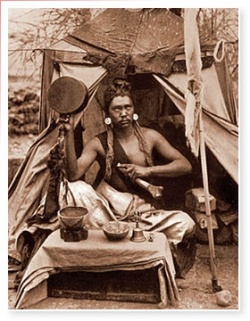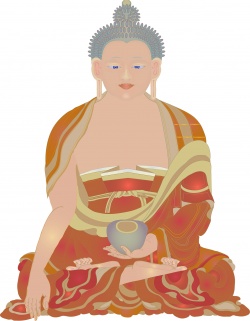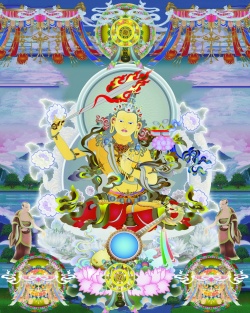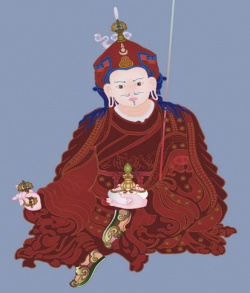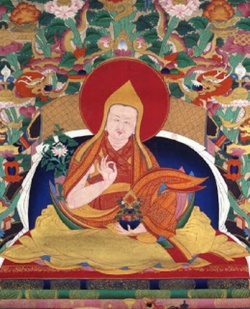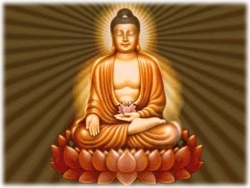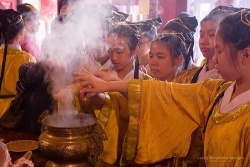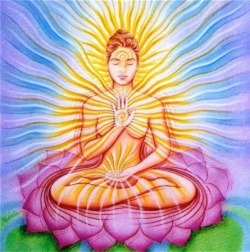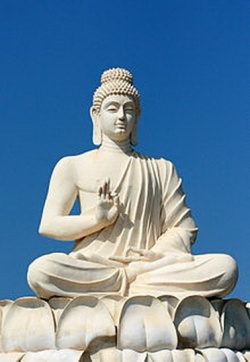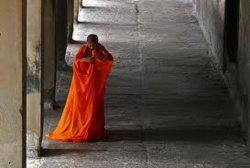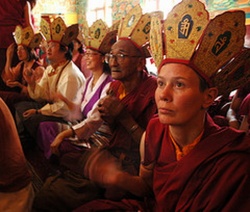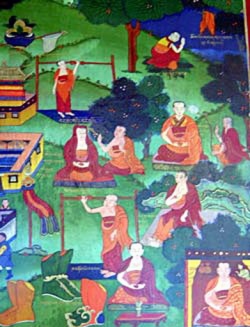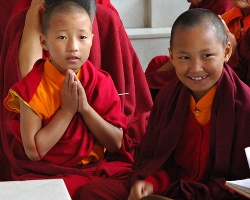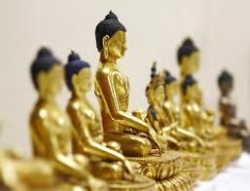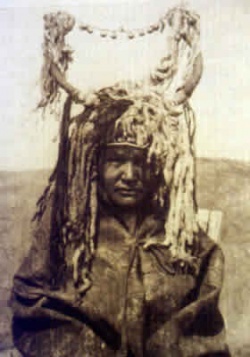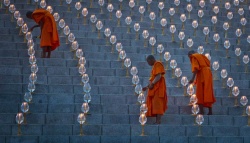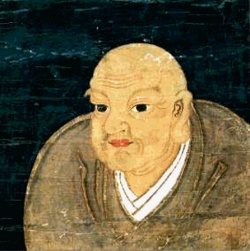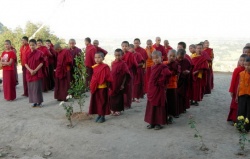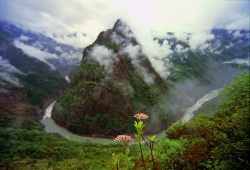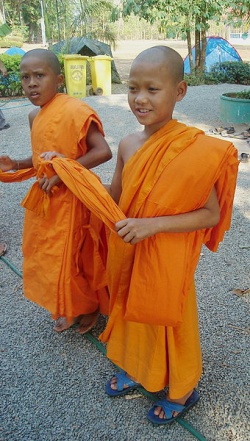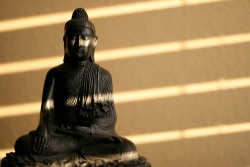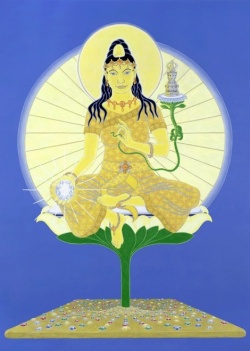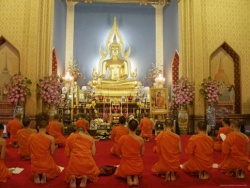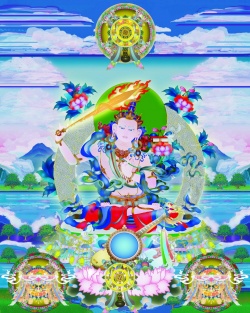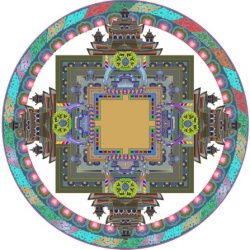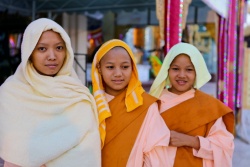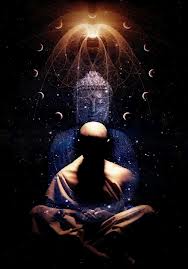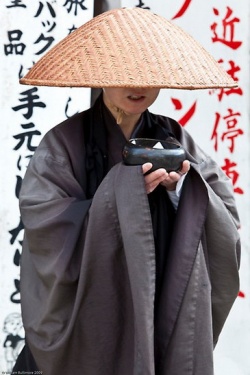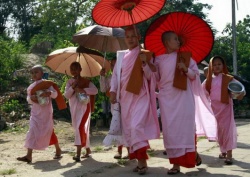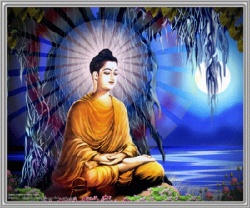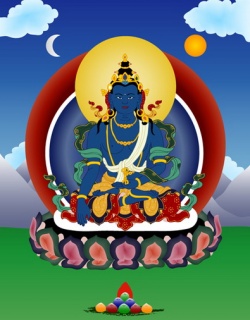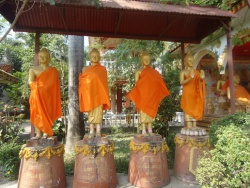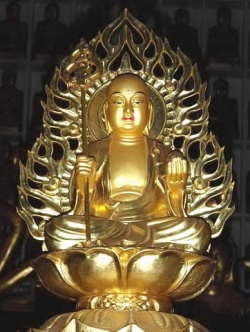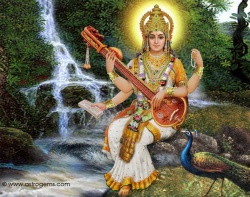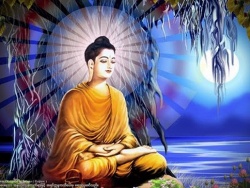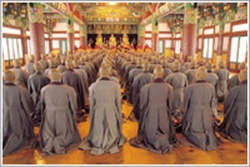Empowerment of Chig She Kun Drol (Knowing One Thing, Everything is Liberated)
Dharma Teachings from Sangye Nyenpa Rinpoche
Empowerment of Chig She Kun Drol (Knowing One Thing, Everything is Liberated)
3-10 April 2010
Benchen Karma Kamtshang Ling,
Johor Bahru, Malaysia
This Chig She Kün Drol consists of the empowerment of forty-five deities, extracted from many Dharma texts by H.H. the 9th Karmapa. For ordinary practitioners like us, it is a support for our daily practice.
Three roots:
In Vajrayana, we talk about the three roots:
(i) Guru: The source of all blessings
(ii) Deity: The source of all accomplishments
(iii) Protector: The source of all activities.
In Vajrayana, it is necessary to have the three roots. Without the three roots, you cannot talk about Vajrayana practice.
Vajrayana––Development stage and Accomplishment stage:
In the practice of Vajrayana, there are two main points, which are the two stages of meditation: Development stage and Accomplishment stage. In Tibetan, it is called kyerim (skyed rim) and dzogrim (rdzogs rim). If one lacks such knowledge and enters into the Vajrayana, one is only participating in an empowerment and some pujas, the benefit that one receives is very little, because of the lack of these two stages of practice. So these two stages are very important. Every Vajrayana practitioner, if departing from these two stages, even if one were to practice the Dharma very diligently, the development of one’s practice will be very slow, with little benefit.
The purpose of practising the deity is not just to have the image, thangka and statue of the deity. Just the form of these deities alone is not effective. You need to understand what these forms represent, their symbolic meaning. By bringing these into your meditation, you gain realization of the truth. Until now, our mind has always been unable to see the true nature because of delusion. All the Buddhas, Bodhisattvas and masters use this skilful method to point us to the path that will lead us to the ultimate truth. So when you are meditating on the deity, think and visualise the deity’s colour, expression and characteristics. Understand that the deity is not substantially existing. Through the practice of the deity, we realise the ultimate true nature.
Of course, we cannot deny that at the moment we are unable to see the truth. So we need the three roots––guru, deity and protector. If you say that everything is emptiness, so there are no three roots, then who would the guru, deity and protector be existing for? Of course the Buddhas, Bodhisattvas and enlightened beings do not need these. But to us, beginning Vajrayana practitioners, this is a profound path that is easy to do. It is depending on this skilful means that we have the opportunity to gain enlightenment in one lifetime. If without this skilful means, if we are only looking at the many thangkas and statues with peaceful and wrathful deities, it would just be like going to the museum. It is only the form. So for practitioners who are seriously practising Vajrayana, the key to your practice is the development stage and accomplishment stage.
In order to transform negative thoughts to positive thoughts, to transform the impure to pure, during the development stage, we visualise the deities in their peaceful or wrathful forms to transform negative thoughts. Ultimately, these do not truly exist. During the accomplishment stage, we realise that one’s mind is inseparable from the Dharmadhatu and Dharmakaya. In this way, the practitioner is able to actualise the practice without contradiction. This is very important in the practice of Tibetan Buddhism.
Explanation is more important than the empowerment:
If I were to only recite this text, it is very easy. But I think explaining its content is much more important than the actual empowerment itself. The explanation should come before the empowerment, because I believe that many of the participants are at different stages of practice and from different backgrounds. Some may understand, while some may not. So I will translate for you all. These are not my teachings, but teachings by my great masters. I am only responsible for passing the message. I feel that if I were to only give you empowerment, it would be like a liar. There is no benefit, definitely no benefit. I am not perfect, still on the path of learning, but it is my responsibility to share the Dharma with you.
Transmission of the Chig She Kun Drol:
I received this empowerment at the age of twelve, from H.H. the 16th Karmapa Rangjung Rigpa’i Dorje. Now I am transmitting it to you. This is very meaningful to me, because the blessing is very precious. So it is my honor to have the opportunity to transmit this lineage to you.
Importance of understanding the practice:
We need to understand the practice of the three roots of guru, deity and protector. If we practise without understanding the situation, this will result in after practising for 1, 2, 3 or 4 years, you will feel very tired and prefer to go and sleep. You think that you have already practised the entire Vajrayana practices for five years, practising Mahakala and so on, but have not gained anything. This is because you have not received the teachings. It is very terrible. Now, even though we have very little time, and I am not very skilled, but by giving you some explanation during these nine days of empowerment, this will benefit you more. I hope that you will listen attentively and remember the teachings in your heart.
Meaning of “Knowing one thing, everything is liberated”:
Now it is very important to introduce the title of this text. I would like to tell you not to have too high expectations or be overly interested, that would be very troublesome. “Oh, is this guy cheating us? Be careful!” So don’t be misled by the words, and misunderstand the meaning. This title is a direct translation. Why is the name “Knowing one thing, everything is liberated”? It has two levels of meaning. If after you receive the empowerment and teachings, you start to practise the development stage very seriously, you practise it very well, gain realisation, and spontaneously reach the accomplishment stage of practice, and finally you are able to practise the development and accomplishment stages in union. When the practitioner is able to attain the inseparable practice of the development and accomplishment stages, such accomplishment can be referred to as “Knowing one thing, everything is liberated”.
It’s not like after these nine days you will be accomplished. From my side, I am 100%, 200% sure that it’s not possible. From your side, I don’t know, maybe, you decide yourself. Even though you cannot gain accomplishment through these nine day of empowerment, it is still meaningful. It is related to your practice, it is very good. As long as you are careful, you know the method, go according with the instructions, without too much exaggeration, practise according to the Dharma, there is the possibility of “Knowing one thing, everything is liberated”.
We are certain that in this very short lifetime, we are unable to practise all the hundreds and thousands of deities. But for instance, if you practise the White Tara according to the instructions of the developing and accomplishment stages, you do not need any extra deities, because all the deities are within this single deity, the White Tara is the embodiment of all the deities. Sometimes we get confused after having received the empowerment of many different deities, this is because of a lack of understanding. One deity can be all deities. You may recite the mantras of many deities for many months and years, but if you understand, you will discover that just practising one deity in accordance with the Dharma is sufficient.
Refuge and Bodhicitta are necessary to receive empowerment:
Before receiving the empowerment, it is very important to take refuge. Without refuge, you are not a Buddhist. But just having refuge is not enough, you still need to give rise to Bodhicitta, because without Bodhicitta, you are not a Mahayana practitioner. These two points are the basis of all Dharma practices. To receive the blessings of the deities, we must have this kind of understanding and then recite.
Transforming our body, speech and mind:
During the actual empowerment, if a Vajrayana practitioner remains in the form of an ordinary person, he or she will not be able to receive the empowerment. So we need to transform our body, speech and mind into the body, speech and mind of the White Tara, which are inseparable with us. Ultimately speaking, our true nature is the Dharmakaya and Dharmadhatu. Because the mind is confused and unable to understand clearly, so we need to receive empowerment and practise the deity.
What is empowerment?
‘Empowerment’ in Sanskrit is ‘Abhisheka’. Whether it is the vase empowerment or torma empowerment, we have to understand that all these substances do not truly exist. If we understand wrongly with our stupid ideas, that is not the real empowerment.
Focus your mind and visualise that the form of the White Tara is invited from the purelands of all the Buddhas and Bodhisattvas and dissolves into your own body, speech and mind; and you are inseparable from White Tara. In this natural state, you have the opportunity to realise or see the true nature. This is real empowerment. Then these vase, torma, Dharma images are not needed anymore. Before we realise the nature of mind, these relative objects are still necessary. Because we need them to realise the ultimate truth. All these deities from different lineages are not different in essence. It is because we need these skilful means from different lineages, not because the deities need that.
Lineage coming from H.H. the 16th Karmapa:
This is the entire set of the Tara empowerment, so I don’t wish to complete them separately. You decide for yourself; if you can recite the mantras, that’s very good. It is not necessary to achieve a certain number, the best is to recite continuously. To me, this lineage is so rare and precious, it has come from H.H. the 16th Karmapa, it is very fortunate. If you can practise the development and accomplishment stages properly, you will not waste your time. I hope everyone will have a serious attitude towards empowerment. It is not for entertainment. It is the intention of the Karmapa’s lineage.
Different forms of deities manifesting from emptiness:
Generally, we always think that there are different deities, like peaceful, wrathful and semi-wrathful etc. Ultimately, what we have to realise is that these different forms of the deities are inseparable from the true nature of our mind. Our mind is originally not different from the Dharmadhatu, not different from the emptiness. ‘Emptiness’ in Sanskrit is shunyata. Its meaning is much vaster than the English ‘emptiness’. From shunyata manifests the forms of different deities, that is to help beginners approach Dharma practice in the right direction. This is why in Vajrayana, you need to receive empowerment, enter the mandala and receive teachings. All practices are meant to lead practitioners directly to the ultimate truth.
Three kinds of empowerment:
In his dohas, great master Milarepa mentioned three types of initiations. ‘Empowerment’ in Tibetan is wang (dbang). In Sanskrit it is abhisheka. The Sanskrit meaning is wider than the Tibetan. The meaning is transformation, transforming your body, speech and mind into the body, speech and mind of the ultimate form of the deity. Because of a lack of understanding, until now, no matter how many deities we have practised, how many mantras we have recited, we have yet to realise the truth, our chance of seeing the truth is still very low.
There are three kinds of empowerment: outer, inner and ultimate empowerment. For practitioners who are interested to learn the Vajrayana, this is a very important lesson. To receive empowerment, it is important to understand these three kinds of empowerment.
The outer empowerment is to give blessing in name. From the vase empowerment, to the deity’s image or statue, nectar, the edible and delicious fruit and candy etc., giving you empowerment through these substances––that is the outer empowerment; it is not the real empowerment. However, in order to receive the inner and ultimate empowerment, the outer empowerment is necessary. Without outer empowerment, one cannot obtain the inner and ultimate empowerment. To beginners, the outer empowerment is quite important.
Once we obtain the outer empowerment, we can enter into the inner empowerment. As mentioned before, we transform our body, speech and mind into the particular deity’s body, speech and mind. Through practising, experience will arise, and we realise that ultimately, the body, speech and mind of the deity and our own body, speech and mind are inseparable; they are not different. This is inner empowerment.
Finally it is the ultimate empowerment. Yesterday I explained why we receive empowerment. Now we visualise that from all the purelands of the Buddhas and Bodhisattvas, you invite the infinite Buddhas and Bodhisattvas in the form of the deity coming and dissolving into your body, speech and mind. At this time, you are free from distraction, and in the natural state, you have the chance to see the truth. At the moment of seeing the truth, that is the ultimate abhisheka. You have realised the true nature of the mind, which is also known as Mahamudra, Maha-ati, Great Madhyamaka. To realise the mind’s true nature, we have to receive empowerment. Once we have realised the nature of mind, we do not need these substances like torma, vase and other empowerment objects. So empowerment does not mean using the substantial torma to touch your forehead, throat and heart. In order to realise the true nature of the mind, we receive the outer empowerment all the way to the ultimate empowerment.
Diligence and wisdom are necessary:
So we must understand this precious teaching by the great master Milarepa. We should keep it in mind. This is very important for our daily practice. In this way we will not lose the direction in our Dharma practice. If we do not know the right method in our practice, and there is mistake in our practice, this is due to the lack of understanding of the practice itself, so we are unable to apply the instructions. So we have to remember these important teachings in our heart, and avoid making mistakes in our practice. All of us have come here to participate in this empowerment, not simply to make a connection with the deity. If so, it would be sufficient just to give the oral transmission of the mantra. Empowerment is deeper. We are requesting the deities to help us remove our ignorance, dualism and disturbing emotions.
Vajrayana is even faster. It is not like you are just lying down there, not doing anything, and waiting for the practice to work for you. The practitioner’s diligence, wisdom and the instructions that one has received, have to be combined altogether, in order to make quick improvements in one’s practice. This is the meaning of Vajrayana. If not, if you treat it like a kind of magic, with some amazing power, immediate transformation, this has never happened in history. We say that the great master Milarepa is able to fly in the sky like a bird, swim in the lake like a fish. This is not magic. It is the result of Milarepa’s diligence in practice. If you wish to fly, you have to go through diligence and wisdom. Without any effort, if you try to fly, you will fall down, and you may lose your life. So practice needs to be stable. Do not seek for quick results. Do not worry about whether it takes a long time or not. Practise with wisdom and diligence.
Refuge and Bodhicitta:
Next we begin the empowerment. First we take refuge in the Buddha, Dharma and Sangha. The meaning is very profound. Because without refuge, you are not a Buddhist. Similarly, it is not enough to just take refuge in the Triple Gem––Buddha, Dharma and Sangha. Because Mahayana is the foundation of Vajrayana, without Mahayana as a basis, you cannot practise Vajrayana. In order to approach the practice of Vajrayana, we have to give rise to Bodhicitta. Without Bodhicitta you are not a Mahayana practitioner. With this understanding, recite after me.
Visualisation:
I’ll like to remind you again, when I say “visualise now”, as explained yesterday, in Vajrayana, you definitely cannot receive the deity’s blessing with your ordinary body, speech and mind. This is very important. Ultimately speaking, we do not need to deny, our body, speech and mind are originally inseparable from the body, speech and mind of the deity. Because of confusion and obscuration, we are unable to see this. Through the blessing of the deity and our own effort, we can see this. Therefore we participate in the empowerment.
Sometimes we get confused by the images of the deities with many hands holding many different instruments. We need to understand that there are two kinds of visualisation. The first is for beginners, in the beginning, we can just do general visualisation. Just visualise that “I am the deity”, and feel that you are the deity. You do not need to visualise every part, because this is very difficult. So in the beginning, do not be too concerned about visualising clearly, just slowly train yourself. The other method is to visualise every part very clearly, everything is very clear. For now, we just need to look at the image calmly, think that the deity is inseparable from me, I am inseparable from the deity, and that is enough. Just think that in the Dharmadhatu, shunyata and our body, speech and mind are originally inseparable, just that is enough.
Three vehicles are inter-related:
We all wish to gain enlightenment within one lifetime, that’s why we enter into the Vajrayana. The three vehicles––Hinayana, Mahayana and Vajrayana––are actually inter-related. Without the Hinayana as foundation, without removing obstacles, it is very difficult to enter into the Mahayana. Without proper Mahayana practice, one cannot enter into the practice of the Vajrayana. The Buddha turned the wheel of the Dharma sequentially, starting from the first turning of the Dharma wheel in Varanasi, India, when he taught the Four Noble Truths, then gradually he taught the Mahayana, and then the Vajrayana. We have to understand the particular circumstances of these methods, and understand that they are all inter-related.
Buddha hopes that we become Buddhas:
Some religious people think that Buddhism is a religion. That is incorrect. The Buddha did not think in this way. The Buddha encouraged us to gain perfect enlightenment through different methods. The Buddha doesn’t hope that you become a Buddhist, he hopes that you can become a Buddha. The Buddha already sees all sentient beings as equal. It is because of our obscuration and confusion that our qualities cannot develop. The Buddha taught us how to develop our Buddha qualities. From the Hinayana, to the Mahayana and Vajrayana, all the teachings are to dispel our dark ignorance. Every stage of the practice is for this very purpose. There is no practice that is not for this purpose. So we have to practise very seriously. This is very worthwhile.
We need to remove our suffering:
Once again, I remind you that the Buddha taught the Four Noble Truths at Varanasi, Deer Park. He first began these very touching teachings with “Know suffering”. This tells us how important that is. If you do not understand the Four Noble Truths, all your practices will be wasted. Because what you are thinking and what you are doing are contradictory. Your thinking and conduct should not contradict each other. The Buddha taught us to know suffering. This is the first message. Just knowing suffering is not enough. The next message you need to know is the cause of suffering. The Buddha’s teaching is systematic and follows a sequence. You always say that you do not have wisdom, you are busy with your business, busy with your family. All these kinds of excuses. On one hand you wish to remove suffering, on the other hand you are lazy. What you think and what you do are not matching with each other. Even the Buddha would be exhausted, I think so. All the Buddhas and Bodhisattvas have sacrificed so much for us, all these are just for our sake, not for their own sake. Yet we do not seriously prostrate and recite, we even think if we are being cheated. Actually we are cheating ourselves. The Buddhas and Bodhisattvas do not need our respect, prostration and recitation. It’s we ourselves who need to accumulate merit.
So do not waste your life anymore, do not waste time. Every year, we remain at the same level, still the same mindset, still an ordinary person, we have never changed. We need to change and improve. The Buddha has taught us very clearly, but the Buddha is unable to remove the suffering of our body and mind. We need to get rid of our own suffering. We have already heard these Dharma teachings, and understand how to get rid of suffering. You yourself are responsible for it. Nobody can help to remove your suffering.
Visualisation:
We visualise the image of the deity, then invite all the Buddhas and Bodhisattvas in the form of the deity. The big ones are as big are Mt. Sumeru. The small ones are as small as sesame seeds. Like rain falling into the sea, infinite numbers of these deities dissolve into ourselves. Our body, speech and mind are inseparable with the body, speech and mind of the deity.
Remembering the teachings:
Very often, something that we remember today, tomorrow we forget. Continuity is very important. When H.H. Dilgo Khyentse Rinpoche gave empowerment, he said that reciting this particular Manjushri mantra will sharpen our wisdom, and also strengthen our memory, so that we can remember and not forget. This is my own experience, when we recite this mantra, even though it is a little long, but if you practise seriously, it will help us sharpen our wisdom, and we can remember and not forget. The teachings we have received will be stored very well in our memory, and we will not forget them. This is what we need. When we receive teachings, we need to remember them for a long time and not to forget them. This is very beneficial for our practice.
Devotion, wisdom and diligence:
These empowerments come from a very precious tradition. As I have reminded you before, this was bestowed by H.H. the 16th Karmapa at Rumtek Monastery to many Rinpoches. Such a precious tradition with unbroken lineage of transmission can bring about great benefit. Just receiving empowerment is not enough. I once again remind you to recite the mantra of the deity. In the textbook, you have the images and mantras of the deities. But if you only read about the benefits of those deities, it’s not a good idea. Actually the benefits and qualities of the deities are already there, whether or not you read or mention them, the deity’s qualities are doubtlessly there; but whether or not you benefit from that, depends on individuals. It is very important that practitioners continuously practise with wisdom and diligence. If you can actually engage in practice in accordance with the Dharma, then all the qualities, merit, blessing, power and miraculous powers are all there. We do not need to have too much expectation. If we can practise with devotion, wisdom and diligence, in accordance with the teachings, then the merit and qualities are there. This is definite.
Motivation:
We engage in the Dharma practice physically, such as doing prostrations, circumambulation, and any movement related to virtue. Verbally, we do recitation, chant prayers, and supplicate to Buddhas and Bodhisattvas. Mentally, we generate bodhicitta, compassion, loving-kindness and so forth. All these are very much based on motivation. Motivation is very important. If there is a slight mistake in your motivation, even if you were to accumulate a large amount of meritorious acts, your achievement or benefit would be so-so. Always remind yourself, at the beginning of any Dharma practice, to have the right motivation.
Reasoning and rationality:
The Theravadin path emphasizes the practice of renunciation, which means the practice of the Four Noble Truths. That helps to open up your mind. Why do we practise? Why do we need to practise? What is the purpose of Dharma practice? We need to practise with reason. Without reasoning, just engaging in Dharma practice does not help us. The Buddha always encouraged us to include the rational or reasoning process. Without that, the practice will not help us. Therefore every time when we engage in the Dharma practice––whether practising alone at home or doing it together with other practitioners; no matter where or how––we always need to reason. Open up your mind. Now your mind is very dull, full of ideas, and always seeking for endless blessings. If you could open up your mind, which means open up your wisdom, you will know how to handle and approach the right direction to practise. Therefore it is essential to examine your motivation and reason for engaging in the Dharma practice. It will be beneficial if you begin any practice with the rational process.
Purpose of all Dharma practices:
The Theravadins meditate on the Four Noble Truths. Why? To purify negative deeds and disturbing emotions. We have a lot of underlying disturbing emotions, which we are unable to peel out. We have a lot of barriers.
Then the Mahayana practice. Why it is ‘Maha’ or ‘higher’? It’s because of loving-kindness and compassion. The practice is also to purify or transform negativities into practice.
The Vajrayana practice has two stages of meditation: the development stage of meditation, and accomplishment stage of meditation. Both are to transform our Five Poisons / negativities/ emotions into the Five Wisdoms.
Same purpose, different capabilities:
So although there are different levels of the Buddha’s teachings, when individuals apply them into practice, they all have the same purpose. The only difference is our capabilities. If we have enough capability, we can approach the Vajrayana, whereby its remedy, method and path work much faster. The Mahayana path works a little slower. The Theravadin path works much slower. But it is just a matter of time. The Buddha was very professional, but he skilfully taught according to our abilities. He never said that we must practise in a certain way, but gave us choices. All these choices have the same purpose.
Motivation: For oneself or all sentient beings?
What I am trying to tell you is, as we are Dharma practitioners, particularly Vajrayana practitioners, sometimes there are mistakes in our concept. Of course, they are not serious mistakes but slight mistakes. For most of us, when we go into the temple or attend ceremonies of puja or initiation, our motivation is expectation: “I have come to get the benefits of long life, good health, good business, good family life.” We are within this compound, can’t get out. Very few of us come for all sentient beings. It is very obvious. I am not insulting you, but telling you the truth. We can’t deny that. Therefore, we should seek improvement by examining our motivation. We should examine our motivation. We claim that we are Buddhists, especially ‘Vajrayana practitioners’––that’s quite high. So we need to examine these things very carefully. Who will examine for you? No one reads your mind. We should read our own mind, motivation and thinking.
If we examine each and every practice of ours, there is a slimmer chance of making mistakes. There are about 90-100 of you over here. Who have you come here for? Very few of you have come to take initiation to help sentient beings. Forget about sentient beings, just for the people in Malaysia, or in Johor Bahru. Very little. Our motivation, loving-kindness and compassion are limited. We have to make our motivation limitless, then the benefit is there. If you practice and recite with such motivation, then there will truly be benefit.
Deities do not truly exist, but we cannot say they are not there:
There are many deities and Dharma protectors in peaceful and wrathful forms––none of them truly exists. They are just reflections or manifestations of the Buddha, from the Dharmakaya and Dharmadhatu, in order to help sentient beings. None of these inherently exist. Though we say that they do not truly exist, we cannot say that they are not there. Because we are not at that level. In order to reach that level, we apply the practice individually. We cannot say that all of them are emptiness, because in that case, when we have a headache, we can simply say that it is emptiness and not there, so there is no need to go to the doctor or hospital.
No instant change:
When we say ‘blessings’, do not expect instant transformation. You think that the minute you drink something, you will transform. The Buddha is professional, but not that much. He is so kind and compassionate. He has done a lot of things, and sacrificed his life for sentient beings. He has shown us how to practise. If we listen to his instructions, follow his direction, and do everything seriously, we will all become Buddhas. The Buddha is confident. He has given us the direction. Don’t expect instant blessing. Some people go to a master and say, “Rinpoche has given me the blessing and tomorrow I will have power.” No one can do that.
Importance of refuge and bodhicitta:
In general, the refuge and bodhicitta verses are not included in the empowerment. But we need to recite them in the beginning of the empowerment. This indicates that without these two (refuge and bodhicitta), there is no way to receive the empowerment blessings from the mandala and deity. They are the fundamental qualities for individuals to receive the empowerment blessings. Therefore, when you recite, you should do it attentively, with the knowledge of how important these two are. Then it will be very beneficial.
Choose the toughest path:
You always expect the mantra to be easy, like “OM AH HUNG”. When the mantra is long, your face also becomes long. That is not good. When it is tough, it is beneficial for us. This is 100% sure. My great master H.H. Dilgo Khyentse Rinpoche used to recite this particular mantra (Jampel Tsenjod) when he was a child, at a minimum of 100 times a day, or more at times. Great masters like these never say that they are doing big things, they always say that they are doing small things. That is why they are great masters, and are very knowledgeable. They go for the toughest part. We go for the easiest path. We choose the easiest mantra. They do not go for the easy ones. We should try the tough ones. Do not say that it is long. If we are always trying to look for the next easiest mantra in the book, very soon we will finish the book. It is very important.
Recite mantra to receive blessing:
The Manjushri is the empowerment of all the wisdom of all the Buddhas. Now that you have received the transmission, you should recite it 10, 15, 20 times or more, in order for the blessings to remain in the individual. To receive the blessing of the lineage or transmission, it is really important to remind oneself to recite the mantra in the morning, afternoon or any time of the day.
Meaning of ‘vajra’:
When we talk about ‘Vajrayana’, we commonly know this (Rinpoche holds a vajra) as the vajra, and this (Rinpoche holds a bell) as the bell. ‘Vajra’ means ‘changelessness’. What does ‘changelessness’ mean? ‘Changelessness’ means there is supposed to be ‘change’, and then there is ‘changelessness’. What is ‘change’? It is the relative truth, which is the so-called sense of Samsara and Nirvana. Samsara is the place where there are lots of illusions. You see many different things from the conceptual mind. E.g. the six realms do not truly / inherently exist, but because of the deluded mind, because of the fundamental powerful ignorance, you see the six realms as being truly out there. This is the Samsaric point of view or vision. I use the term ‘relative’ here. As long as you are within the compound of the Samsaric field, you will see them as true.
Ripening of the mind:
Gradually, when all your senses develop by doing practice, meditation and training your mind, in Vajrayana Buddhism, we often use the term ‘ripening the mind’. So far, our mind is not ripened, so the mind is wild. From that point of view, everything is changing from time to time. From yesterday to today, tomorrow to the day after, week to week, year to year. Each and every moment, everything is changing. What does this mean? This means they are not true, not inherently existent. They are only seemingly there, not truly there. ‘Change’ means they are not always there. Even though you may see, hear, smell, taste them, they are seemingly / relative there. The more your wisdom increases, the more your mind ripens, you will see the difference. What you previously see / hear are not truly there. This is vajra, which means ‘changelessness’, the opposite of ‘change’, ‘relativity’ and ‘Samsara’.
Initiation is the door to receiving blessings and ripen the mind:
By training and transforming through applying the extensive teachings and instructions within the individual, one slowly ripens the mind, through the blessing of the lineage, empowerment, deities and protectors etc. The meaning of ‘initiation’ is the door to enter into the temple. Without the door, you can’t get in. To enter into the temple through the window is sensitive, and is not the right way. People will immediately suspect that you are a thief. They won’t think that you are coming for prayers. Entering through the window is not the right way. You must enter through the door; it is the proper way. In the same way, in the practice Vajrayana Buddhism, other than initiation there is no way that will assist you to receive blessings. The mind is ripened through initiation. Quoted from a Tibetan Vajrayana textbook, entitled “Explanation of the Development Stage of Meditation”, it is said that: “Initiation is done to get into the temple or mandala. The blessing of the deity and mandala is received within the individual through the initiation of body, speech and mind. Therefore initiation itself helps to ripen the mind.” You always ask: How to ripen our mind? The answer is: Initiation.
Proper and improper initiation:
Initiation can be proper or improper. You can examine or judge yourself whether you have received proper or improper initiation. If the more initiation you receive, the wilder your mindset, this is an indication of improper initiation. This means the initiation doesn’t suit / work for you. When you receive initiation, if you are not only receiving it, but at the same time you are also meditating, and you see your mind ripening, becoming calm; day by day, moment to moment, you see your mind more clearly; somehow you feel that you have now seen the truth; even though the truth is invisible, still you feel close to seeing the truth––this is ‘ripening’.
Sometimes you don’t know the meaning of ‘ripening’. It means that you understand more clearly, the qualities of the mind are more visible, and you get closer and closer to seeing the truth of your mind. It does not mean that you have seen the truth, but you are going to see, you have a feeling or indication that the truth is there. This means that the mind is being ripened through the blessing of the empowerment.
Ripening of the mind, then transformation occurs spontaneously:
The more you tame the mind, the more your mind ripens. Then slowly you start to transform. Transformation is not easy. Though we say that the body is transformed into the deity, and that the speech and mind are also transformed, but transformation is not so easy. Why? Because at the beginning, first you have to ripen the mind by training. Slowly, after having first ripened the mind, you transform your mind into the mind of the deity. Then you can transform your speech into the mantra. And then transform the body into the form of the deity. You start from the mind. We always say ‘body, speech, mind’, but that is the general sequence. In practice, what are we ripening? The mind. Because of the power of the ripening of the mind, then one’s mind is transformed into the Dharmadhatu / Dharmakaya / emptiness. Then one’s body is transformed into the form of the deity, which is luminosity. All sounds or voices that we hear are inseparable with the sound of mantra. This sound that comes from the clarity of mind itself, is relatively a ‘sound’, but inseparable with emptiness. It is very systematic. In Vajrayana Buddhism, you have to approach it in the right direction and go step by step. Then transformation occurs. Then the ‘vajra’ or ‘changelessness’ happens. If not, just by playing some drums and music, and making tormas, one will only benefit by a little. If you want to get a thangka, you can go to the shop. If you want to buy good statues, you can go to Kathmandu, where you can get statues of the best quality and at a low price. But that is not really Vajrayana Buddhism. We are not talking about material stuff, but about training the mind to transform all into perfection.
First you need to ripen the mind, then transformation happens effortlessly. Once the ripening of mind happens, transformation occurs spontaneously, without effort. There is no need to ask: Where is transformation? You will not lose it. It will come when you ripen your mind. Because transformation exists within the individual. You do not need to go outside to find. The problem is you are unable to bring it out because of delusion. The mind is too wild. You have no control. You go through all kinds of difficulties, problems, and hard time, yet you enjoy them. Even though you complain about problems, but when you are given a direction, you can’t do it. We go for temporary relief, instant change.
We have to go through the sequence in this way. It is very much in order. First you ripen the mind, then transformation occurs. Any Vajrayana method, without going through the ripening of the mind and transformation, even though you can call it ‘Vajrayana’, it is not really ‘Vajrayana’. ‘Vajrayana’ means ‘changelessness’. By the instructions of the great masters, once you realise the true nature of mind, and discover that this quality exists in every sentient being, then you can be called a ‘Vajrayana practitioner’. This is very important.
Why I am telling you this is because I myself find it quite uncomfortable to just read something, give some water and torma, and then people remain the same. You may be reciting the mantra, but there is no transformation in your life. What communication is there between you and I? Therefore the explanation is needed, because if not I would be cheating you. That wouldn’t be good. You may say that you have gone for something for a few days, and after that when you go back, you are still the same. It is my duty to explain. Your job is to keep them in mind. This is a democratic country. I just introduce you, and tell you to be aware of this and that. In future, you may go for other lessons or teachings, which may be different in style, but the points are the same. So please pay attention and be aware of these things.
Practice Bodhicitta with body, speech and mind:
After receiving initiation, the practitioner should try to generate Bodhicitta everyday. Not only when you see friends, but also when you see enemies. When you see your enemies, you should give them a handshake. “I have received the Avalokiteshvara empowerment. Now you are my friend. I don’t mind that you hate me, but thank you for helping me to develop Bodhicitta.” Do it not only with your mouth, but in your heart. If you sweet talk but feel irritated in your heart, that is not good. You should do it physically, verbally and mentally.
Wrathful manifestations symbolise greater compassion:
Why are there peaceful and wrathful deities? Sometimes we may think that wrathful means having more anger. This is because we lack knowledge and have a lot of thoughts. We need to have clear information. The wrathful manifestations mean having more compassion. In the family, sometimes the kids are very naughty. The mother is very kind, always using nice words, giving sweet talk. But if the child doesn’t listen, sometimes the mother will beat the child. But this beating is not out of hate, but because of having more compassion. That is the only option that the mother has. Similarly, the ‘wrathful’ form is symbolism for greater compassion, not anger. Vajrayana is very sensitive, risky and dangerous if we do not have the proper explanations. Therefore be very careful when you talk about the peaceful and wrathful deities. If you know of such information, you will clearly know why there are peaceful and wrathful manifestations.
Different aspects, same in essence:
The peaceful Avalokiteshvara and wrathful Vajrapani are different aspects, but the same in essence. Do not think that they are separate, having different colours, shapes etc. Do not fixate, as that will become a big obstacle for your practice. Because of the different levels of sentient beings, the Buddha has no choice. The purpose is for our transformation, for us to realize more. Though we see different aspects, they are the same in essence. Such knowledge is very important. Without such knowledge, however much effort we put in, it will still be difficult for us to gain realization.
Are you a real Buddhist or Dharma practitioner?
You say that, “I’m a Buddhist, a Dharma practitioner. I believe in the Buddha, Dharma and Sangha.” But do you really consider yourself to be a real Dharma practitioner? In what sense do you believe in yourself? That is very important. Are you a Dharma practitioner in your daily life? You simply say that you're a Buddhist without considering this. Even though you have ‘Buddhism’ as your identity, you lose the meaning of ‘Buddhism’, yet claim that you are a genuine Dharma practitioner. This does not make much sense.
Refuge is not simply a hair-cutting ceremony:
Sometimes we believe that by performing the ceremony of cutting hair, we become a Buddhist. Today you go to a master, “Can I go for refuge in the Buddha, Dharma and Sangha through you?” The master says, “Ok, no problem. I can do it.” It is very easy, only takes a few minutes. But there is no consideration of what it means to be Buddhist, both for the master and the person intending to be a Buddhist. Later on, you find a lot of faults in the practice and you might think: “I did not have enough understanding. I have no confidence. Why did I become a Buddhist?” As you practise, you engage in a lot of mistakes. Therefore, before you go through the cutting-hair ceremony––so-called refuge vow––you should get ready. You need to have determination, and approach Buddhism in the right direction.
Long time before, during the good old days in Tibet / India, there used to be very genuine systems that allowed for the performance of such ceremonies. Before you took refuge, the master would give you a simple lesson on the Four Noble Truths. The master will let you think about what Samsara is, why you intend to become a Buddhist, what is Buddhism, what are the benefits of refuge, the purpose of refuge, what do you practise after taking refuge, what do you need to know before taking refuge etc. After a while, the master would examine you, “Are you ready?” You may say, “Yes”. Or you may say, “Not ready. I have considered a lot, but I am not there”. In that case it is fine, at least that is good, you are really ripening your mind. You are qualified.
I tell this in all the countries I go to. Parents bring their baby to the masters for refuge. Poor baby, no idea! The baby sees the scissors and gets very frightened, yet at the same time, they don’t know what is happening. The parents say, “You took refuge 15-20 years before.” And the child thinks: “Really? How stupid. What talks? Cut hair? What is the meaning?” There is no knowledge, and no meaning. So if parents do this, of course it is establishing connection with the Buddha, Dharma and Sangha, yet it is not very meaningful in the sense of becoming a Buddhist.
If you really want to be a genuine Buddhist practitioner you should have knowledge about who is Buddha, what is Buddhism, and not simply with the idea of Buddha being something like the three statues standing behind. You think: “This is Buddha.” That is not the Buddha, it is a symbol of the Buddha. With regard to the Dharma, you have the notion that it is simply a few textbooks. As for the Sangha, you think it is just a few spiritual masters. So you need to build up your knowledge of the Buddha, Dharma and Sangha.
Buddha versus sentient beings:
Who is the Buddha? He is a person who is fully awakened. We are not awake. We are still wandering in the Samsaric dream, roaming here and there, and not fully awakened. The Buddha is fully awakened. He guides us to the right direction. In terms of qualities, the Buddha is the same as sentient beings. But the difference is that the Buddha is awakened. This means that he has actualised his qualities. We have not actualised our qualities, so we are sentient beings. But each and every sentient being has the qualities innate in us. The qualities are there, at all times. This is how you can distinguish between the Buddha and sentient beings. Sentient beings are not yet able to wake up, because of a lack of diligence. We are lazy, we have too much enjoyment and too much of roaming around, so we are still there. The Buddha has less enjoyment, not much roaming, and therefore is truly awakened. Through his diligence and hard work, he managed to open up wisdom. Therefore the Buddha is up there, and we are still below. That is the difference. This does not mean that we do not have the innate qualities. We have. The qualities are co-emergently existent. But because we are lacking in diligence, because we have not opened up our wisdom, so sentient beings still wander in Samsara. That is our only difference. It is very simple. We are still sleeping. We need to wake up. Don't sleep for too long.
Respecting the Buddha:
As the Indian great master Chandrakirti said, respecting the Buddha does not mean bowing down or reciting a few prayers. Respecting the Buddha means deep in your heart, having a sense of the knowledge of the Buddha. You have to have the confidence or knowledge of how to get rid of Samsara, how to approach the Dharma in the right direction, and you are fully living in the innate natural qualities that exist in yourself. If you are aware of these, you are a genuine Dharma practitioner.
All of us, we do daily prayers, look at the Buddha statue, buy Buddha statues and keep them, hang them up against the window, on the walls of the dining room and kitchen etc. For what? This is not a Buddha museum. Sometimes it is just decoration. That is really not a good way. All of us should just have a small statue. That is enough. Not necessarily a gigantic one. Without true faith, devotion, and diligence, you can’t enter through the door. Whether the statue is big or small makes no difference. We need to have knowledge and wisdom. That is the most important point of Buddhism.
How to do prostrations in a meaningful way?
Whenever you enter a temple, you see the thangkas and statues, and do three prostrations. At this time, you need to have the knowledge of the Buddha as one who has achieved Buddhahood: “You are the wonderful one who has shown us the right direction. You are fully awakened. You have ignited wisdom. You encourage us to have open up our wisdom and become like you.” In this way, your prostration is very meaningful.
Not asking for blessing in this way: “I have no money. The stock market has gone down. Please bless my land, property, house...” The Buddha also gets confused: “What is the stock market?” He is intelligent, but he does not know the stock market. It is confusing him.
So if you do prostrations, “Give me blessings to open up my wisdom, to realize the true nature of my mind, to help all sentient beings. Like what you do for us, I will do for them. You sacrificed your life, went through tough times for us, took on responsibility for us. I will follow you.” If you think in this way, there is no need to do prostrations. Just thinking of this, the Buddha will smile at you and you will get blessings. There is no need to go into a room, shut the door, do prayers everyday. The Buddha wouldn’t even be interested to go to you, because he doesn’t like such things.
When we think of the Buddha, we need to have proper concepts, then we can get the blessings of the lineage, deities, dharma protectors, and all else included.
Different manifestations, many methods:
If these deities are the same in essence, why is it that some are white and some are blue? This is not their problem, but ours. Because we are too deluded, one method can’t work. So the Buddha very skilfully manifested in different colours (blue, yellow) and different forms (semi-wrathful, wrathful, peaceful) to help us relatively.
Relatively, this deity is very special for the curing of diseases especially paralysis, and for dealing with certain harmful beings in Tibet. However, do not think that this deity is a ‘paralysis specialist’. That is a big mistake. It is a wrathful manifestation of the wrathful Guru Rinpoche, in order to cure various illnesses.
We tend to think that if we want long life, we look for Amitayus; clearance of obstacles, we go to Vajrakilaya or Mahakala. We think that if we want long life, we should not practise Mahakala, but the Amitayus. This way of thinking is because we have too much delusion and disturbing emotions. It is a serious matter. We should get rid of all these.
importance of Dharma discussion
As Milarepa said, “If there is an uncomfortable feeling within the Dharma practitioner, the best way to get rid of this discomfort is through Dharma discussion.” Milarepa said that it is through discussion that we can get rid of doubts and unclear points. Whatever makes you uncomfortable and undecided, you can reduce these thoughts through discussion. Therefore Dharma discussion is very important.
True meaning of Dharma
The ‘Buddha’ is a fully awakened individual. In Tibetan it is ‘sangye’. As Dharma practitioners, this means that we are now following his instructions, which is known as ‘Dharma’ in Sanskrit.
Dharma refers to his doctrine and instructions. To be a perfect practitioner––one who is practising––we need to apply the words / instructions / advice of the Buddha. ‘Dharma’ is not simply placing a few textbooks on the altar, prostrate to them daily, covering them with a scarf, and burning some strong incense, thinking: “I’ve spent so much money buying these books from the bookshop”. This makes no sense. The Dharma is to be applied, which means bringing it into your life, which means tasting it, experiencing it, and familiarising with it. This is Dharma practice.
Chö’ in Tibetan commonly means ‘correction’. You have to correct yourself––bodily, verbally and mentally. If our bodily behaviour engages in negativities, we try to correct it into positive behaviour. If we verbally engage in negativities, we should correct ourselves with positive verbal behaviour. Mental negativities, we should transform them into positive thoughts. That is ‘chö’.
Chö means correction, which means that we have to do it. No one can correct you by force. Law and regulations can force you to do something somewhere, but can’t change you. The Buddha knows that very clearly. So he gives us advice. We should examine ourselves, think, experience, taste and correct ourselves. Then transformation can happen. That is the Dharma.
How to receive blessings?
There is one very important point we need to be aware off. We always say ‘blessing’. We think it means seeing a master, him touching our head, and then we say, “I will be able to practise very well from tomorrow onwards or after a year. I am very busy this year, so one year later I will do it. So please bless me to transform my mind.” There is no such thing. If that were possible, the Buddha would have done it for us. The Buddha is very kind to sentient beings, so he should have done it, but why not? Why would he want us to accumulate merit, do prostrations, offer mandala and go through such difficult and hard work? Is he trying to punish us? Why? This is because liberation cannot come merely from blessing, but from your perfect actions. If you transform your body, speech and mind, blessing works for you. If you remain the same, such as engaging in killing, give rise to negative thoughts etc., and you think that blessings will work for you, it doesn’t work like that. Sometimes receiving too much blessings spoil you. You think that there is no need to practise the Dharma, your guru will help you. You see him touching your head and you think you are fine. That is wrong conception.
The blessings of the guru, yidam, Dharma protectors and Buddhas, all go along with your positivity. If you transform the negativities of your body, speech and mind into something positive, you will receive blessings.
You can read the life story of the Buddha, and those of the great masters like Tilopa, Naropa, Marpa and Milarepa. Read about how difficult their lives have been. They have done so much for us. So simply receiving blessings is not enough. We are definitely not greater than them. They are great masters yet they do very hard work. Read the story of Milarepa. Lots of inspiration. Simply reading their life story will also give us blessings. Because each and every individual naturally has the seed––true nature, compassion and loving-kindness. Combined with your pure motivation and hard work in the Buddhadharma, you will be able to receive blessings.
True meaning of blessing:
Blessing does not mean giving you something drinkable and eatable. It means something that pacifies your mind. ‘Blessing’ in Tibetan is ‘jin lab’. ‘Jin’ means calm and peaceful. ‘Lab’ means receiving or engaging. Through diligence, wisdom, you will be able to wake up. Opening up your mind is wisdom; diligence is continuity. As Nagarjuna said, both diligence and wisdom are needed.
Blessings in the Mahamudra tradition:
In the Mahamudra tradition, ‘jin lab’ or ‘blessings’ is often used to mean meditating or remaining in the natural state of mind, free from distraction. Because of ‘jin lab’, I can remain in the natural state of mind.
Every time we chant “Dorje chang wang...”, we read the line: “Gyur pad zin no nam thar jin gyi lob”. This means: “I’m going to hold the lineage. Please grant your blessing.” By ‘holding the lineage’, this means that we are going to do what the masters have done, which is doing practice. Therefore please bless me. Because we practice, we have the conditions, so we can receive the blessings. If not, no blessing. If we hold the lineage, we will get the blessings. So by holding the lineage, which means seriously engaging in the Mahamudra, we will get the blessings.
Dharma practice happens at all time:
Some of you may have come from afar, while some may be nearer. All of us are here for Dharma practice. Though you call it “receiving initiation”, it is also practising the Dharma. Practice does not mean doing the practice when you have time, and not practising when you have no time. Practice means doing it at any time: when you are sleeping you are still practising, when walking on the street, talking to your friends, you are also practising. If you say that you have no time, you are lying. You have time. Practice does not ‘need time’. Practice means applying the Buddha’s instructions. What the Buddha said that we have to avoid or adopt, we follow accordingly. This is practice. Carry it with you all the time. There is no need for extra time.
Before you sleep, generate Bodhicitta, compassion and loving-kindness, and then you sleep. Whether you are walking, talking, eating and drinking, you can bring all of them into your practice.
All deities are ultimately inseparable:
I remind you again that it will be good if you can recite the mantras everyday. You have received five empowerments today. If you recite all of them, very good. In case you are unable to do so, at least recite one, with the knowledge that these different aspects of the deities are inseparable. There is no separation, they are all inherently existing. Build up the knowledge that they are all the same. This is very important. If you do not have such knowledge, you will have the misconception that these deities are of different colours, characteristics and shapes. Therefore you cannot get the blessings.
All of them are ultimately the same. Why? Because they all are manifestations of Dharmadhatu and Dharmakaya, so in that sense they are not different. But relatively, because of our deluded mind, we cannot catch the point, so out of skilful means, they manifest in different forms. It is very important for Vajrayana practitioners to know that the recitation or visualisation of one deity is inseparable with all the rest of the deities. In future, when you go for other lessons, it is also about this knowledge. When you practice, if you lack this knowledge, it will not be efficient or effective. Therefore there is a need for us to develop this knowledge. It is a very important point in Vajrayana practice, especially visualisation.
Finding the right key in Buddhist practice:
Sometimes as Buddhist practitioners, you consider Buddhism as a religion, in the sense that you respect the Buddha as God. You believe that there is a huge space (or distance) between you and the Buddha. You feel that you are always an ordinary being, while the Buddhas and Bodhisattvas are always great beings up there. Then what is your job? You think that you just need to get blessings. You enjoy good food, roam around, get into trouble, and request for blessings. This is very simple thinking. This is not the right way. It is a wrong view in Buddhist practice.
Sometimes you may get confused because there are too many practices. In general, there is the Theravada. Within that, there are subdivisions and different levels of Theravadin practices. Then there is the Mahayana. Within that, there are different types of view, background and philosophies. All of them talk in different ways. You may be confused. What for? Do we really need all these? Are they compulsory or obligatory? No. If you find the right key, all the rest of the practices are related; all the rest of the view, meditation and conduct are included.
The next question that arises in your mind is: What is the right key? Right view, right meditation and right conduct. If you are able to perfect these three––perfection of view, perfection of meditation, and perfection of conduct––then you will get the perfection of result. The result arises or happens spontaneously, effortlessly.
Right view:
When we talk about ‘view’, sometimes you may have the sense that this is something to do with philosophy, not something that ordinary people practise. This is wrong conception. To have right conduct, you must have right meditation. To build up right meditation, you must have right view. Therefore the right view is: anything you see / hear / smell / taste / touch etc., all seemingly appear and arise. Like that. There is no reason. Sometimes things just come and go. If we lack such knowledge, we will have problems. We have too much fixation on things being inherently or truly existing. We have the tendency, habit, and big fixation toward the object. We do not feel sufficient with them being seemingly there. We think that they are really out there.
So the right view is just being satisfied with the realization and understanding that things are seemingly there but not truly there. Without right view, we can’t develop our practice.
If you could really build up your knowledge of right view, your difficulties will be much lesser. All the rest of our problems, e.g. sickness, mental disorder and unexpected negative circumstances, come to us because of wrong view, because you do not have solid right view. If you have right view, though problems and difficulties may come to you, you can manage or handle them. They can’t control you; you can control and adjust the difficulties and problems. So somehow, you are not too much burnt by circumstances, because you have the right view.
Sometimes we have wrong view. We just recite a few mantras, and do a few prostrations. We think that ‘right view’ belongs to the philosophy section, not my section. That is wrong view. Right view is very important in practice.
The many forms of Vajrayana activities such as empowerment and puja, are all based on right view. Without right view, your practice cannot develop. Practice does not mean being inside a room, shutting the door. You say that you have no time. Of course you have no time for that, I can understand. I also have no time. ‘Time’ means you are not wasting. Each and every time, you are mindful. Make it meaningful. This is Dharma practice.
Right meditation:
The word ‘meditation’ is very common nowadays. Everywhere, people say, “I’m doing meditation.” Meditation is not only about forcing your mind. Meditation makes your mind clearer and clearer; it helps you to see the truth of your mind. Without assistance from right view, you cannot do meditation correctly. Sometimes when you practice, you find faults and mistakes in your meditation, because you did not achieve right view before. Therefore, no matter which meditation you do, whether it is Mahamudra or Maha-ati, you need the right view.
For example, in Vajrayana meditation there are two different stages: 1) development stage of meditation; 2) accomplishment stage of meditation. During the generation or development stage, you need the right view. Without right view, you will visualise wrongly. Also, without right view, you will not be able to do the accomplishment stage of meditation. Each and every aspect of meditation always originates with the help of right view.
When you face any problem or intolerable pain and suffering, think of the right view. These problems do not truly exist, they are just reflections of negative thoughts. Because of ignorance, dualism, the dualistic point of view, we feel suffering. As Nagarjuna said, “Ultimately, everything is just the reflection of mind.” Just that. We meditate to understand this. We are unable to actualise this, so we try to remain in this knowledge. The more meditation we do, the more you will actualise this. This means meditation. It is regular practice, not some philosophical or extraordinary meditation. As practitioners, we simply apply this practice, which is swift, fast and safe.
Without this, as in Western countries, without support from the right view, they force themselves through their meditation. Sometimes they say that they are flying. That is wrong, that is an illusion. Too much makeup. Fake meditation. You feel that you are flying, then you stop, and bye-bye. Very dangerous. Therefore, to avoid such mistakes, be on the safe side. Go along with the right view, right instructions, and right meditation. Be on the safe side, and it will be perfect.
Right conduct:
Conduct means the activities you do with your body, speech and mind. With right view and right meditation, you will naturally transform your conduct into virtue. You will naturally, effortlessly bring them into virtuous action. You will not engage in negativities because of correct view and correct meditation. With correct meditation, you are totally trained well. With the right view, your mind is very clear, very mindful. Because you are mindful, your physical movement will spontaneously or naturally transform into virtue. So these three––right view, meditation and conduct––are general practices for all Buddhist practitioners. Whether you are in a temple, with your family, alone, walking or talking, at each and every moment you should carry on these practices. It is very important. It will help to sustain your practice, and help you develop further.
Treat all experiences equally:
Everyday you go through different experiences. Most of the time it’s unhappy, while happy times are very little. You may be happy in the morning, but not in the afternoon; or you may be happy in the afternoon, but cry in the evening. The time for smiling is very little, while the time for crying or being angry is a lot. So you become Buddhist in order to get rid of this, not simply for blessing. It is not like the master gives you something, you eat, and then tomorrow you feel something. Or after drinking something, you immediately feel nauseous or sweaty. Then you think that the deity has come to you, and you become very powerful.
According to the instruction of Indian master Nagarjuna, he said that good practice means managing any circumstance that comes to you. Whatever it is good or bad, happy or unhappy, whatever circumstances arise, you equally accept them. This is proof of good practice. If you are happy when good circumstances come, and when bad things happen you go to the master and ask him to bless you, this is wrong practice. The Buddha expects us to manage or solve our problems, because he wants us to develop our mind. Therefore, the right view and right meditation will help you. There is no need to prevent unexpected negative circumstances. So practice means always associating with right view, meditation and conduct.
The blessings of transmission:
It is very important for us to develop knowledge and understanding, especially for Vajrayana practitioners. Without this knowledge, sometimes we make lots of complications. I myself am contented that with this program, I could transmit the valuable, precious transmission from H.H. the 16th Karmapa to Dharma friends. I think what we have done is very remarkable. Not only me. You too, because everyday you attend carefully, and listen attentively. On my side, I have tried my best to transmit the precious transmission to Dharma friends. It is very excellent, a job well done.
The reason why I say that is because, besides our own diligence in Dharma practice, we also need blessings. ‘Blessing’ is a term that all Vajrayana practitioners commonly use. Great masters like H.H. the 16th Karmapa and my other great masters, because of their unconditional compassion and loving-kindness, they work for us, compose texts, do transmissions, and edit books for us. The blessings ultimately come from their experiences and high realization. Whatever they have done for us is remarkable and extraordinary. Transmission means the great master passes on to another great master, who then passes on to another great master. So as we receive transmission through this unbroken lineage, we receive blessings.
The question is: how to receive blessings, or how to benefit from transmission? The answer is, if you apply the practices within the individual, you can gain benefits and receive blessings. Besides receiving teachings, transmission, and instructions, you now apply them, and combine with wisdom, intelligence and hard work. By applying them, you will doubtlessly get benefits and blessings.
Guru and root guru:
The word ‘guru’ is a Sanskrit term. In Tibetan, it is ‘lama’. The guru has two aspects: the general guru, and root guru. Sometimes an ordinary Dharma practitioner goes to a master / lama / Rinpoche and asks, “Can you be my guru?”
I can say, “Ok, no problem. I can be your guru”, which means giving teachings.
“Can you be my root guru?”
Then I have a big question mark. Am I qualified to be a root guru? Do you? We shouldn’t use the word ‘root guru’ too much. ‘Root guru’ is only one; ‘branch’ can be many. You can have 100, 200, 1000 gurus; but only one root guru. If an individual introduces to you the ultimate truth or true nature of mind, and you yourself realises or experiences the true nature of mind, then effortlessly or spontaneously that person becomes your root guru. There is no nomination, no voting; it is not like roaming in shopping centres, thinking: “Can I buy this?” It is a sensitive matter. When an individual introduces to you the true nature of the mind, and you realize it, then even if you deny it, that person is spontaneously your root guru. You can’t deny. If he says, “I am not your root guru”, that is lying. If you say, “He is not my root guru”, you are also lying.
Sometimes it is very easy for you to say, “You are my root guru.” But after some time, the root guru and disciple fight. That is not good. The disciple talks too much behind, and the root guru talks too much. Because there are no conditions for them to become guru and disciple.
It is only at the moment when you realise or recognise the true nature of mind, then at that moment, you call “root guru”. Until then, no matter what happens, you still call “guru”, not “root guru”. If you use too much of ‘root guru’, and have too many roots, then the branches get complicated. This is very important in Vajrayana practice. I say this everywhere, not only in Malaysia. Because when we do the Vajrayana practice, it is good to be on the safe side. Safe for the individual, and then your influence on others will also be positive. It is not only I who am saying this. You can read this in the books, scriptures, and the commentaries of the masters in India. If you are careful about such things as “guru” and “root guru”, then it will build up your Vajrayana practice orderly.
Because we are always attending initiations, pujas, and other Vajrayana ceremonies, sometimes you feel undecided. It makes you feel very restless. When you individually have such knowledge, you feel much more comfortable and relaxed. You will have less chance of getting wrong information from others.
Long life depends on your motivation:
The Amitayus is associated with long life. However, in order to prolong your life through the receiving of the Amitayus empowerment, you need to generate Bodhicitta to help many sentient beings. If you are simply reciting the Amitayus for your own enjoyment, there is no guarantee. Therefore it depends on the individual motivation, the sincere and genuine loving-kindness and compassion, the willingness to help sentient beings that makes the “long life” effective. Do not think that Amitayus is simply a Buddha for long life. It goes along with reason, depending on conditions.
Initiation, secret instruction, reading transmission:
Traditionally, Dharma transmissions include initiation, explanation / secret instruction, and reading transmission. To practise sadhanas or rituals, it is compulsory to receive these transmissions. Without the initiation, secret instruction or reading transmission, one can still perform a particular puja, but there is no blessing from the lineage. In the good old days, masters would emphasize all three steps.
Consistent practice:
Simply receiving initiation is not sufficient. One needs to carry on the practice everyday. These three––right view, meditation and conduct––must be associated with all the rest of your practices. The continuity is very important. It is not just when you are sick you pray to the medicine Buddha. When you are unsuccessful, you practise a certain deity. That would be wrong practice, wrong view. So continuity is important. You need to carry on your practice.
Milarepa:
Why do we do Milarepa tsok in the evening? Traditionally great masters would do the Milarepa tsok after 2, 3 or 5 days of doing any big puja. This is because Milarepa is accepted as a great master, not just by the Kagyupas but by all schools of Buddhism. Even non-Buddhists also accept that he is a great master. If you read his life story, you can sense how wonderful he is. He was a genuine practitioner, and he could sacrifice his life for sentient beings. He said that anybody who calls his name, or in future, those who regret for not having seen him, as long as one calls his name, reads his life story, does practice, it will be the same as seeing him personally.
n Milarepa’s doha, he mentioned that anyone who sees his face, hears his speech, remembers his life story, he wishes that we may see him everywhere, not just in a particular place. Because his great loving-kindness and compassion is always with us. Therefore those who read his life story, practise his sadhana, write, talk, listen to his life story, do prostrations toward his images and life story, make offerings to him, and hold his instructions in one’s mind; in future, anyone who has done good practice, good meditation as he did; even if someone were to simply bring up his name or life story; it would be full of blessing. You must remember, Milarepa went through very difficult and tough practices and sacrificed his life for the sake of sentient beings. As long as one sees or hears his life story, this individual would receive blessings, and would engage in proper Dharma practice.
I think he is really great, because he prayed, wished and has such perfect aspiration, that even by hearing his name, an individual would really be able to engage in Dharma practice because of his blessings. Just as earth, water, fire, wind and space are spacious and pervade all, his blessings, compassion and loving-kindness also pervade all. He aspired that by the connection of touching his cloth, his earth, his stone, wherever he was or he had been to, by touching them, it would help bring us into the Dharma practice. His compassion and loving-kindness is immeasurable. This indicates that, if we do not only read his life story, but also apply Dharma practice just as he did––which was his wish––then the immeasurable blessings will pervade, just like soil and water.
Out of his great compassion for all sentient beings, he made a special aspiration: “I myself, the one who speaks the truth at all times, the one who never lies, I make this aspiration that anyone who hears songs of Truth, the mind will be liberated.”
I have very wonderful transmissions of Milarepa’s dohas. So I am going to sing. At the same time, Dharma friends, please do your best to make prayers and good wishes for the world and all sentient beings. That is very helpful. Even though it is for a short time, you can benefit a lot by making genuine aspiration prayers. Please pray attentively whatever wish to help sentient beings.
Mind in natural state:
Rest your mind in the natural state, which is always free from distraction. The mind has always been completely genuine and has never touched any impurity and fabrication. It has always been pure and transparent.
Meaning of tsok:
Sometimes you misunderstand what tsok means. You think that tsok means enjoying the fruit, biscuit and delicious food. Actually long time ago, tsok was when the great masters gathered in caves, together with dakas and dakinis, enjoying all kinds of food. Not only delicious food, but also dirty food, mixed together and ate them. Because of the power of their knowledge and realisation, they had to power to transform the impure into pure. We have dualism––the notion of good and bad, clean and dirty. We want the clean, but don’t want the dirty. That is dualism, which keeps us far from reality. To avoid such dualism, we practise tsok to transform the poison into medicine, transform the dirty into clean. I also do not have such power. We imitate.
Closing:
Before we do the closing ceremony, from today onwards we will all be busy. But still we can apply our Dharma practice. I always apply the Dharma practice whenever I have the chance. Practice does not mean being alone in a jungle or remote area. Practice means having to deal with our everyday life, having to face difficult situations. It is important to practise the Dharma in our daily lives, it is much faster than practising alone in a cave. Inside the cave, how to know where your practice is going? Tell me. You can’t. You say that there is no anger so far, then when you meet with unpleasant people, your anger arises. Therefore, it is not practical. We need to use everyday circumstances. We need good and bad people, pleasant and unpleasant people. They are all supporters to your practice. They will support you if you are careful. If you are careless, they will not support you, but will make you angrier. So be cautious, mindful, and always alert, each and every time. I am 100% sure that your practice will be perfect.
Dedication of merit:
We should dedicate the merit we have accumulated over the past few days to all sentient beings, may they be liberated from suffering and its causes and be enlightened, and also dedicate merit to the long life of great masters in this world. Not necessarily Buddhist or religious people. There are millions of people that are not religious, but they have good heart, and make great contribution to the world. We need their long life. There are lots of unexpected disasters, like earthquake, tsunami, etc. We dedicate that all kinds of suffering be eliminated, and that all sentient beings get enlightened. All can be enlightened because within each and every being exists the ultimate natural quality. The only difference is whether we acknowledge it or not. If we wake up to the wisdom of our mind, definitely all can be enlightened. Therefore dedicate all your merits in these ways.


